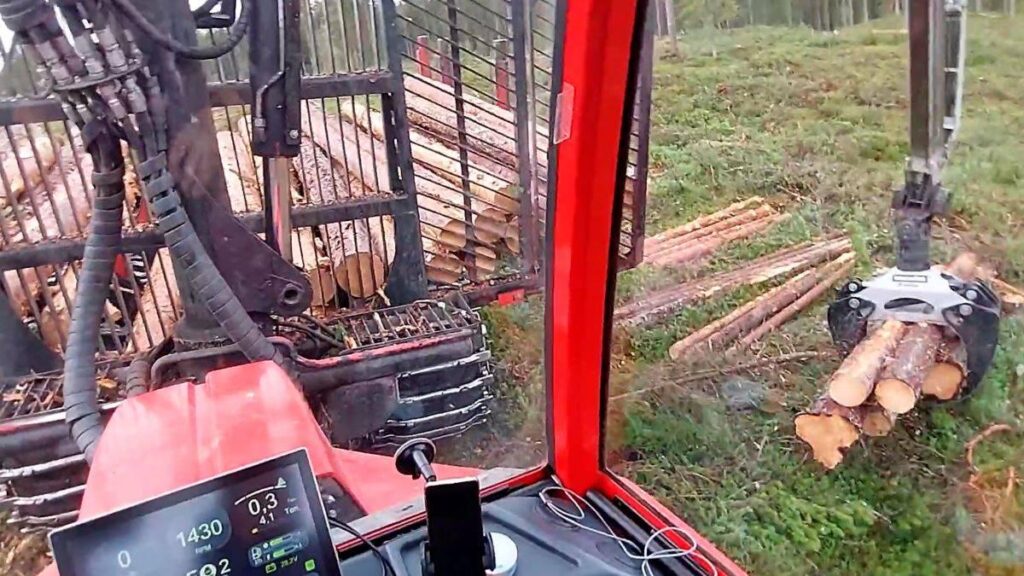(Forest Machine Magazine photo)
In forestry, instructors are used to develop the skills of operators in efficient working methods and handling of the machine. But for many operators, it can be a long time between the times you meet an instructor.
Remote operator training can increase accessibility and make it more attractive. For example, it may be possible to spend more time transferring your knowledge and less time travelling. Teachers at agricultural high schools have in many ways similar tasks, but under different conditions than the instructors.
In this project, the Forestry Research Institute of Sweden developed a technical solution for real-time streaming of video via the 4G network from forest machines and investigated how it can be used by instructors and teachers.
Wide-Angle Importance
The camera was a mobile phone (Samsung A52s) with an app that streamed video (Incidentshare2).
When choosing a camera, one of the most important factors was that the angle of view was large enough for the instructor to get a good idea of the situation. The phone could be attached either to the inside of the machine’s window or worn on the head by the operator. The installation on the window can be used if the machine has a rotating cabin. If the cab is fixed, the camera needs to be mounted on the head for the image to follow the crane. The operator and instructor were speaking via a separate phone line.
A prerequisite for live streaming of video to work is that there is adequate mobile coverage. The phones were equipped with SIM cards from both Telia’s and Telenor’s networks to make it possible to select the network with the best coverage in a particular location. In most of the sites tested in the project, it worked well. The delay in the image to the instructor was then about 1.5 seconds and this was not perceived as a problem, however, when the signal was inadequate, it was frustrating to lose contact and reconnect.
Potential to do More Follow-Ups, Faster Action
Both the instructors and the drivers thought that the system worked well although some operators expressed a preference for working with a one to one instructor that accompanied them in the cab. Others thought it was more relaxed with the remote operator training.
The instructors emphasize that personal contact is important to build trust with operators and that the best use for a feature like this would be follow-ups of previous instructor sessions. The instructors believe that accessibility to this feature could lead to better use of their time and more frequent follow-ups with the operators.
Many instructors also are able to work with the setting of cranes and harvesting heads, they see that this technology is beneficial in spotting any incorrect settings.
Can Be Used as Tool to Analyze Runs
The instructors at the agricultural schools felt that the greatest benefit was the opportunity to record videos where the students can analyze their own skills. They also were pleased to have the opportunity to record their own short instructional videos for new elements in their training.
During training many machines can be working simultaneously on separate harvesting sites in different areas of the country. At the onset of the training instructors often need to provide support on how to get the students started and if, for example the machine gives an error message, can remedy it remotely.
These situations can be solved quickly with the help of a camera in the machine and provide a better use of machine resources in the lessons. Being able to follow the students’ driving live remotely certainly provides the opportunity for immediate support during the practice sessions, but the benefit of instruction in machine operation is limited because the teachers are still nearby.
Built-in Camera in Cab Is Requested
Something that the instructors asked for was an even better overview of the situation around the machine and also to see how the operator’s eye and head movements. They can see this when the camera is pointed at their head, but the quick head movements can make the image difficult to watch.
This was perceived as a disadvantage compared to riding in the machine with the student. A suggestion from one of the instructors was that the camera should be mounted in the driver’s seat and placed above the driver’s head so that the operators head is seen in the picture.
This would offer the instructor a stable overview image where they see the movement of the operators head.
Both the instructors and the teachers expressed that the machines should be equipped with a camera in the cab right from the factory. The system used in the project works well, but it would have been smoother if the equipment was already in place and integrated with the machine.
A freelance method instructor, two instructors at Komatsu Forest and two teachers at Södra Viken agricultural high school participated in the evaluations. The project also collaborated with business developers at Holmen Skog. The Önnesjö Foundation and the Norra Skog Research Foundation each funded half of the project.
This story also appears on Forestry Equipment Guide.
Read the full article here

